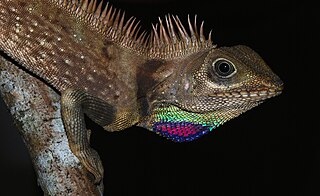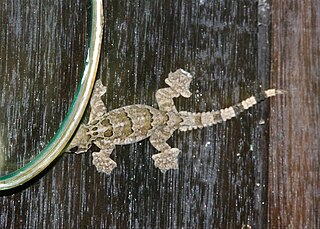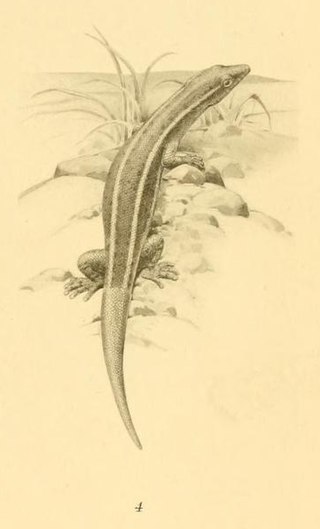
The earless monitor lizard is a semiaquatic, brown lizard native to the Southeast Asian island of Borneo. It is the only living species in the family Lanthanotidae and it is related to the true monitor lizards.

Gehyra mutilata, also known commonly as the common four-clawed gecko, Pacific gecko, stump-toed gecko, sugar gecko in Indonesia, tender-skinned house gecko, and butiki in Filipino, is a species of lizard in the family Gekkonidae. The species is native to Southeast Asia. It has made its way to several areas of the world including Sri Lanka, Indochina, and many of the Pacific Islands. Compared to the common house gecko, the appearance of G. mutilata is somewhat plump, with delicate skin. The skin is usually colored a soft purplish/pinkish gray, with golden spots on younger specimens; these spots eventually fade with age.

Gekko smithii, commonly known as Smith's green-eyed gecko or the large forest gecko, is a species of lizard in the family Gekkonidae. The species is native to mainland Southeast Asia and Indonesia.

The Indo-Pacific gecko, also known commonly as Garnot's house gecko, the fox gecko, and the Assam greyish brown gecko, is a species of lizard in the family Gekkonidae. The species is found in India, across Southeast Asia, Australia, and throughout Polynesia. Adults are about 4 to 5 in in total length. They are seen as dark gray or brown with light markings in daylight and a pale, translucent colour at night. The belly is orange or yellow. The head has a long, narrow snout, hence the name fox gecko. The flattened tail has a row of spiny scales on the lateral edges. The species is parthenogenic – all individuals are female and lay eggs that hatch without requiring male fertilisation.
The minor snake-eyed skink is a species of lizard in the family Scincidae. The species is native to Asia.

Abbott's crested lizard, also known commonly as Abbott's anglehead lizard and Cochran's forest dragon, is a subspecies of lizard in the family Agamidae. The subspecies is native to Malaysia and Thailand.

Gonocephalus bornensis, the Borneo anglehead lizard or Borneo forest dragon, is an agamid lizard endemic to Borneo in Indonesia and Malaysia, and known from Sabah, Kinabalu, Brunei, Sarawak and Kalimantan.

Gonocephalus doriae is a species of arboreal lizard in the family Agamidae. The species is endemic to the island of Borneo.

Gonocephalus bellii, commonly known as Bell's anglehead lizard or Bell's forest dragon, is a species of lizard in the family Agamidae. The species is native to Southeast Asia and Oceania.
The Sabah bow-fingered gecko, also known commonly as Inger's bow-fingered gecko, is a species of lizard in the family Gekkonidae. The species is endemic to Sabah in Malaysia.
Malayodracon is a genus of lizard within the family Agamidae. The genus is monotypic, containing the sole species Malayodracon robinsonii. The species, also known commonly as Robinson's anglehead lizard and Robinson's forest dragon, is endemic to Southeast Asia. No subspecies are recognized as being valid.

Gekko horsfieldii, also known commonly as Horsfield's flying gecko, Horsfield's gliding gecko, and Horsfield's parachute gecko, is a species of lizard in the family Gekkonidae. The species is endemic to Asia.

The Tobago least gecko is a species of lizard in the family Sphaerodactylidae. The species is endemic to the Caribbean and northern South America.

Nucras lalandii, also known commonly as Delalande's sandveld lizard, Delalande's spotted lizard, and Laland's lizard, is a species of wall lizard in the family of true lizards (Lacertidae). The species is native to Southern Africa.

Pedioplanis burchelli, known commonly as Burchell's sand lizard, is a species of lizard in the family Lacertidae. The species is native to Southern Africa.

Pedioplanis lineoocellata, known commonly as the common sand lizard, the ocellated sand lizard, and the spotted sand lizard, is a species of lizard in the family Lacertidae. The species is endemic to Southern Africa. There are three recognized subspecies.

Panaspis wahlbergii, also known commonly as the Angolan snake-eyed skink, the savannah lidless skink, and Wahlberg's snake-eyed skink, is a species of lizard in the family Scincidae. The species is widely distributed in Sub-Saharan Africa. However, it likely represents more than one species.
Tropidophorus beccarii, also known commonly as Beccari's keeled skink and Beccari's water skink, is a species of lizard in the subfamily Lygosominae of the family Scincidae. The species is endemic to the island of Borneo.
Gonocephalus beyschlagi, also known commonly as the Sumatra forest dragon, is a species of lizard in the family Agamidae. The species is native to northern Sumatra, Indonesia.
Dopasia buettikoferi, also known commonly as the Bornean glass snake and Buettikofer's glass lizard, is a species of lizard in the family Anguidae. The species is native to Indonesia and Malaysia on the island of Borneo.














